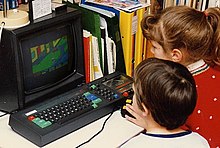Home computer
A home computer is the name given to early personal computers made in the 1970s and 1980s that could be plugged into a television set. They were used for playing video games and doing school work and were usually owned by teenagers. At that time, most adults did not own a computer at all.

Typically, home computers can produce colored graphics, have several sound channels and a keyboard. They use a tape recorder or floppy disk drive to load and store programs. Optionally, home computers may be used with a printer, a game cartridge, a modem, joysticks and a mouse. Many of them display an interactive BASIC prompt at start-up.
Home computers were made possible through the introduction of the microprocessor in the early 1970s. It made computers small, affordable, reliable and power efficient enough that they could be used in homes.
In contrast to home computers, computers used by businesses were either bulky minicomputers or gigantic mainframes. Those computers came with much more memory, with hard disks, one or more computer terminals and a proper operating system. However, such machines needed a lot of space, were very noisy and also were far too expensive for private consumers at the time.
Makers of home computers
change- Commodore
- Atari
- Apple (popular in the US)
- Tandy (popular in the US)
- Sinclair Research Ltd (popular in Europe)
- Amstrad (popular in Europe)
- ASCII Corporation and Microsoft (creators of the MSX, popular in the East Asia and Southeast Asia)
- North Star Computers (active in the US)
- Micro Instrumentation and Telemetry Systems (Altair 8800)